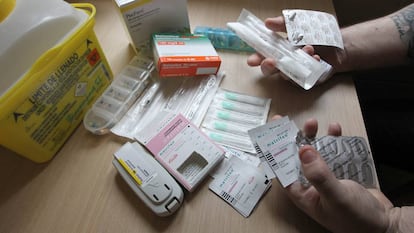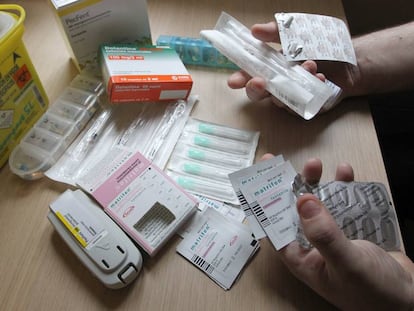Opioid overdoses cause more than 1,000 deaths a year in Spain
According to a first-of-its-kind study, the number of fatalities related to the drug has increased more than 50% in seven years

More than 7,000 people in Spain died from opioid overdoses between 2010 and 2017, according to data from Cádiz University’s Pain Observatory to which EL PAÍS has had access. What’s more, the number of overdoses has risen over this period, from 700 a year at the beginning of the decade to more than a thousand in the last two recorded years. The overall rate has increased by 52%, but the rise has almost doubled among women. According to this data, more than two-thirds of women overdosed on opioids by accident, while the rest were intentional. The group most affected were men between 35 and 54 years of age and women over the age of 65.
Between 2010 and 2017, opioid use in Spain increased by 79%
This is the first time that data on opioid-related deaths (ORD) has been published in Spain. According to research from the Observatory that focused on cases between 2013 and 2016, ORDs are a “problem with serious social costs” that “require special oversight.” Like other similar international studies, the data is based on the International Classification of Diseases (ICD).
Professor Inmaculada Failde, the lead author of the study, says the goal of the research was to compare ORDs in Spain and the United States. According to Failde, based on these findings, it is “very unlikely” that Spain will see the same kind of opioid crisis as in the US, where the epidemic has been claiming more than 50,000 deaths a year. “The standardized death rates in the United States have been between eight and 12 times higher than in Spain,” explains Failde.
According to this expert, “the age groups most affected in almost all the cases were between 35 and 54, although there is a notable spike in the gross rate for people over 65.”
The standardized death rates in the United States have been between eight and 12 times higher than in Spain
Professor Inmaculada Failde, lead author of study
But the research has no insight on why the overdose rate is higher among this age group. Failde explains this was not the goal of the study, and that the data itself does not shed light on the question. Nor are there any other studies in Spain that address this issue. But the Health Ministry and experts consulted by EL PAÍS agree that the “aging population” increases the likelihood of diseases that are treated with opioids. “The greater the use of opioids, the greater the risk of side effects, even the most serious ones,” the experts warn.
The misuse of immediate-release fentanyl medicines is the most-cited cause of ORDs in middle-aged men. This form of the drug, which is taken via inhalers or administered directly under the tongue, immediately alleviates pain, but can also be very addictive, says María Ángeles Canos, the head of the Pain Unit at the La Fe University in Valencia. Canos explains that these products are intended for cancer patients suffering intense and sudden pain, but when given to non-cancer patients, can lead the person to “give up their base treatment, and seek greater and more frequent doses than those that were prescribed.”
The debate over the use of opioids is “delicate” and “uncomfortable,” say most of the experts and public officials consulted by this newspaper. “There used to be fear and rejection towards treating pain. People were suffering unnecessarily,” says Luis Sordo, who teaches at the Medicine School at Madrid’s Complutense University. “Of course there are things that need to be improved, but the fear now is that Spanish patients will end up paying for the mistakes of the United States.”
Opioid use in Europe
Spain is the seventh-biggest consumer of opioids and the fifth-biggest consumer of fentanyl formulations in Europe, according to a study by the Pharmacological Research Institute in Milan, based on data from 2014 to 2016. Germany is at the top of the list, although opioid use in that country is just about half what it is in the US.
Failde says a system is needed to record the consequences and circumstances of opioid use so that “unwarranted alarm” does not lead to a fall in justified opioid prescriptions, and potential drug abuse by at-risk groups can be detected.
Canos warns that prescriptions have “increased notably over the past years, in some cases far from the guidelines and with little patient oversight.” But she rules out that the rise in opioid prescriptions recorded in Spain has come with a significant addiction problem.
Between 2010 and 2017, opioid use in Spain increased by 79%.
English version by Melissa Kitson.
Tu suscripción se está usando en otro dispositivo
¿Quieres añadir otro usuario a tu suscripción?
Si continúas leyendo en este dispositivo, no se podrá leer en el otro.
FlechaTu suscripción se está usando en otro dispositivo y solo puedes acceder a EL PAÍS desde un dispositivo a la vez.
Si quieres compartir tu cuenta, cambia tu suscripción a la modalidad Premium, así podrás añadir otro usuario. Cada uno accederá con su propia cuenta de email, lo que os permitirá personalizar vuestra experiencia en EL PAÍS.
¿Tienes una suscripción de empresa? Accede aquí para contratar más cuentas.
En el caso de no saber quién está usando tu cuenta, te recomendamos cambiar tu contraseña aquí.
Si decides continuar compartiendo tu cuenta, este mensaje se mostrará en tu dispositivo y en el de la otra persona que está usando tu cuenta de forma indefinida, afectando a tu experiencia de lectura. Puedes consultar aquí los términos y condiciones de la suscripción digital.
More information

Spain: Europe’s new cocaine gateway
Archived In
Últimas noticias
Most viewed
- Sinaloa Cartel war is taking its toll on Los Chapitos
- Oona Chaplin: ‘I told James Cameron that I was living in a treehouse and starting a permaculture project with a friend’
- Reinhard Genzel, Nobel laureate in physics: ‘One-minute videos will never give you the truth’
- Why the price of coffee has skyrocketed: from Brazilian plantations to specialty coffee houses
- Silver prices are going crazy: This is what’s fueling the rally










































